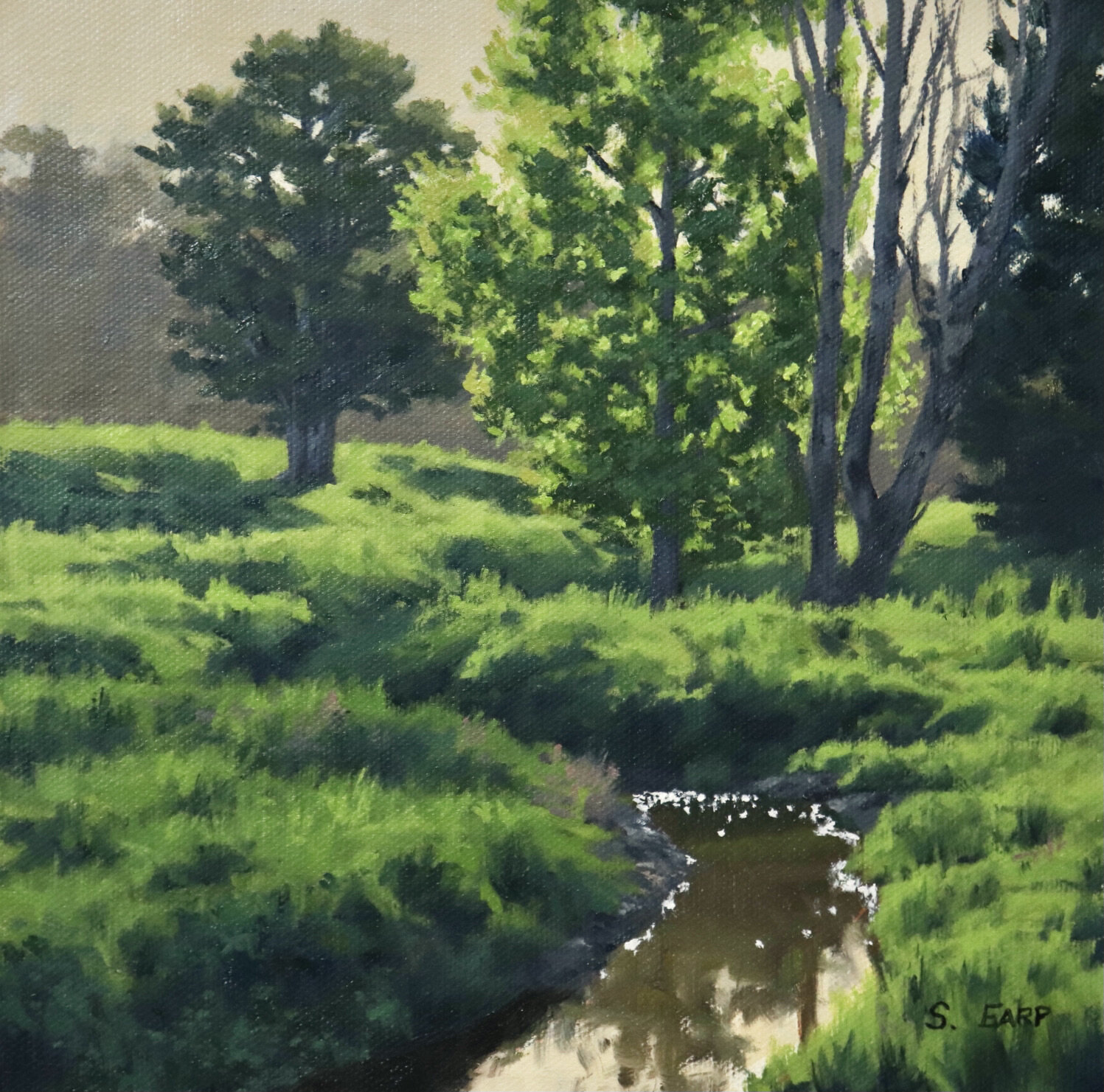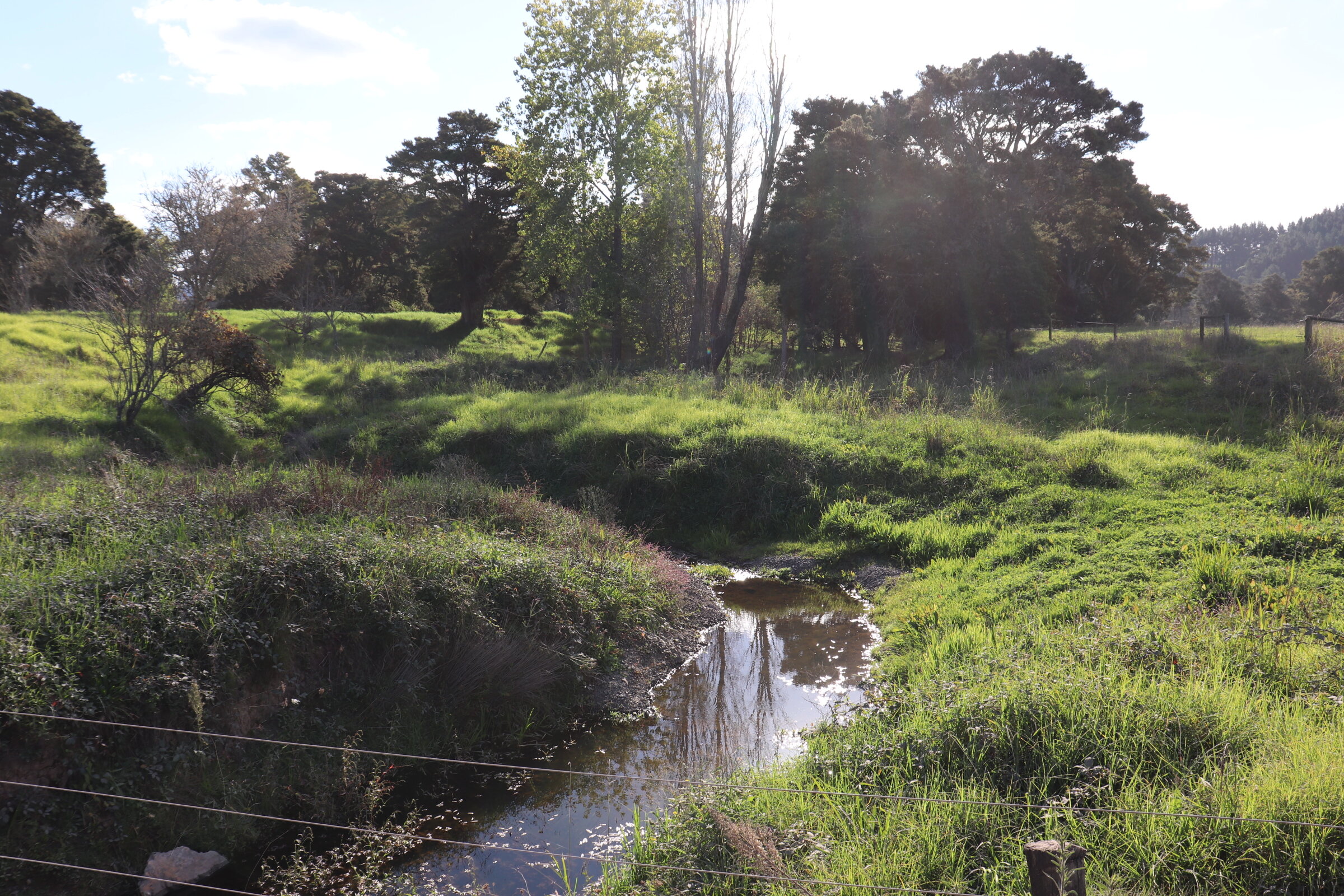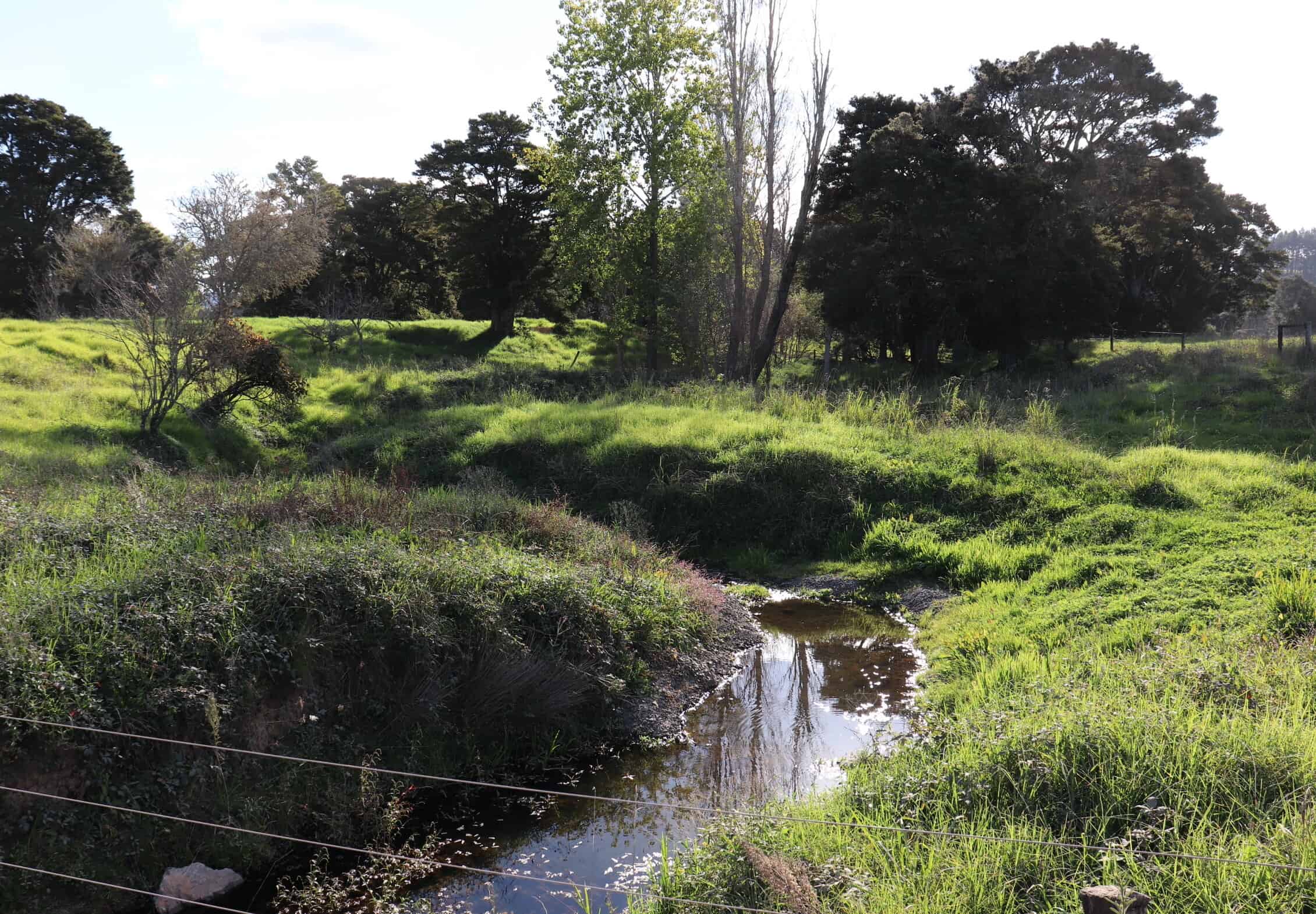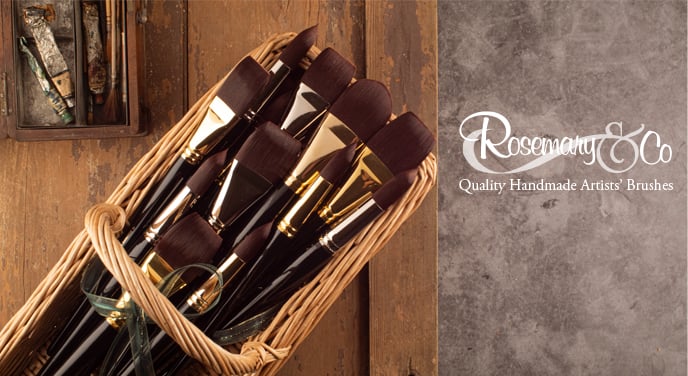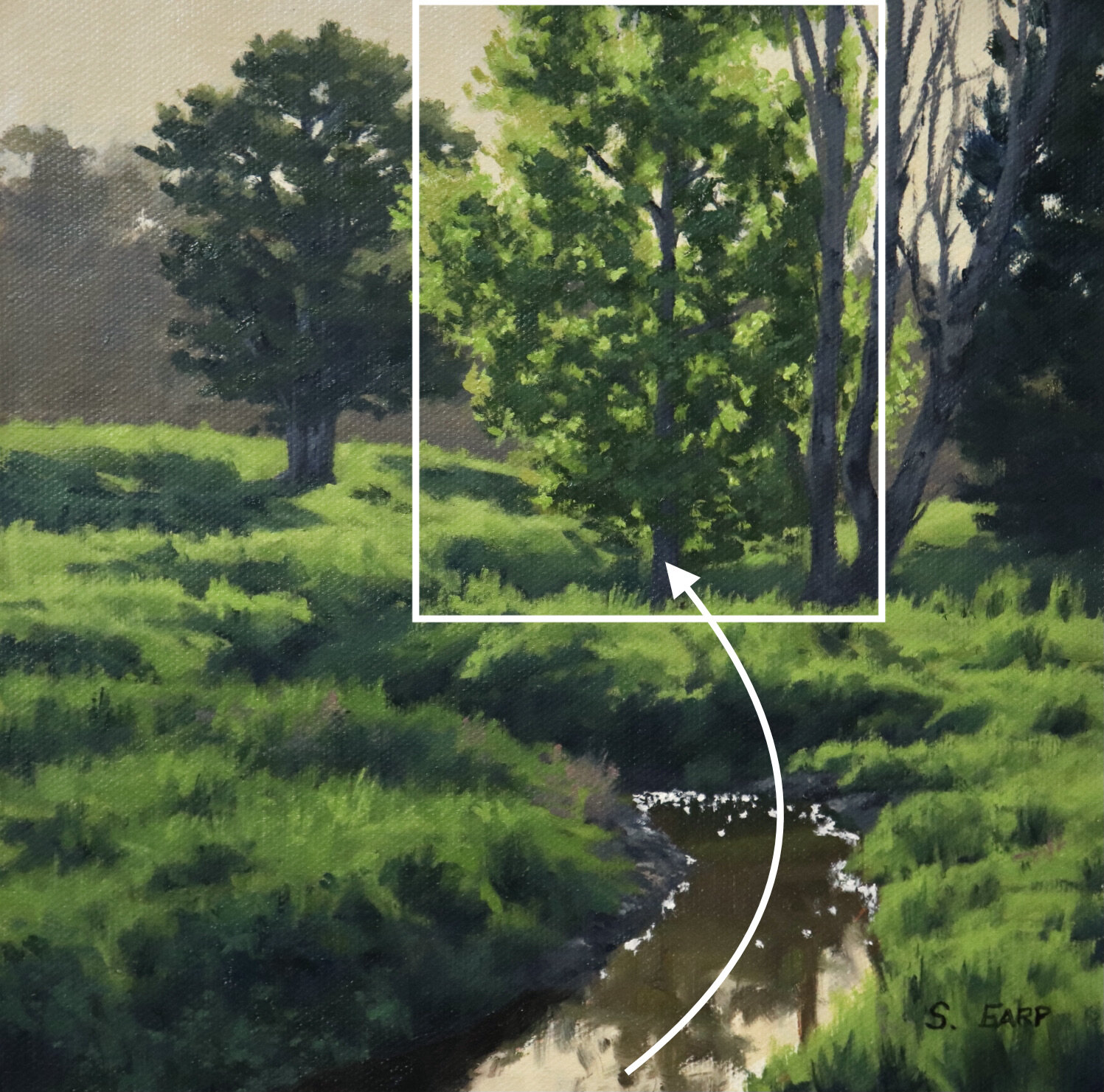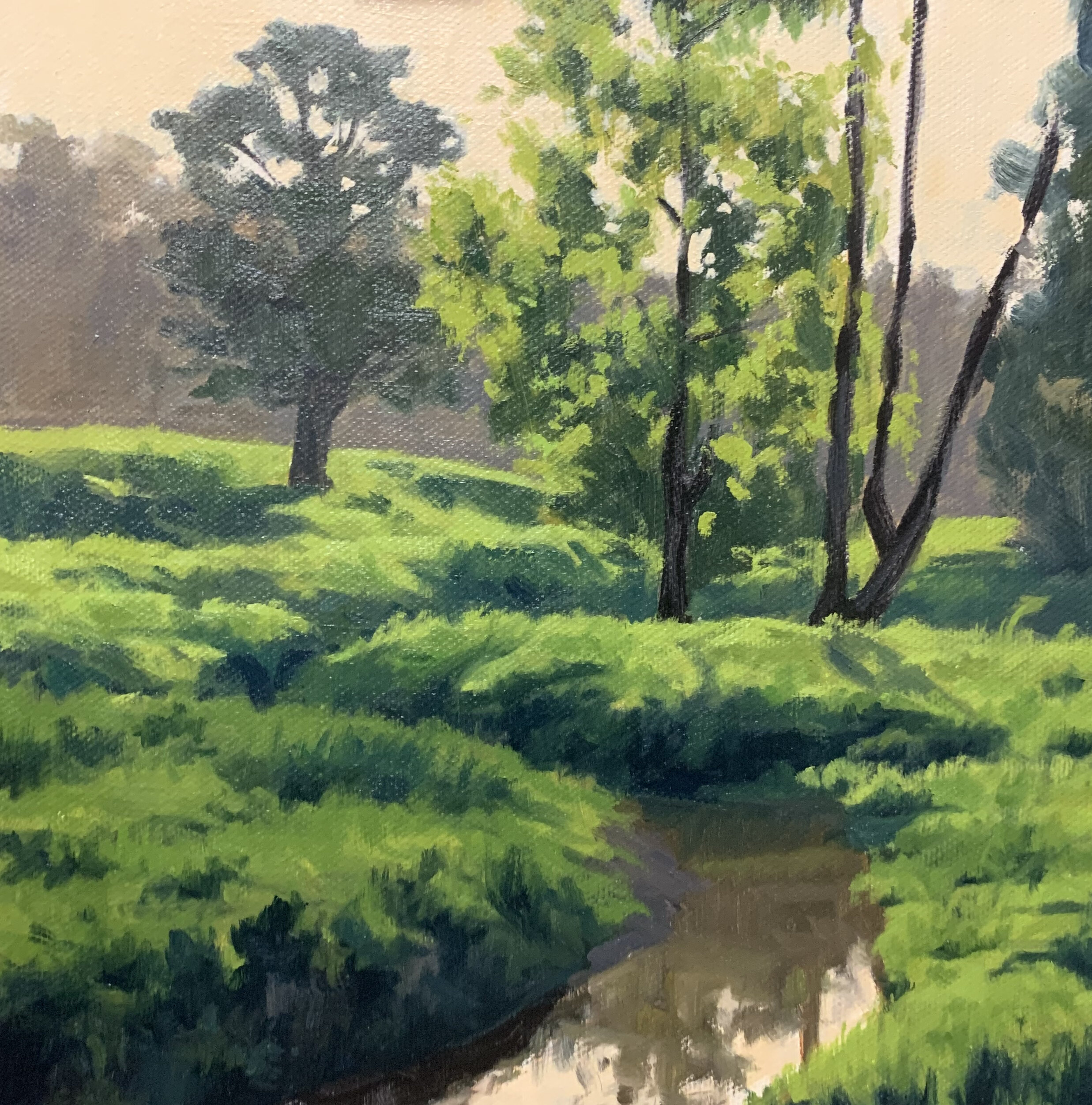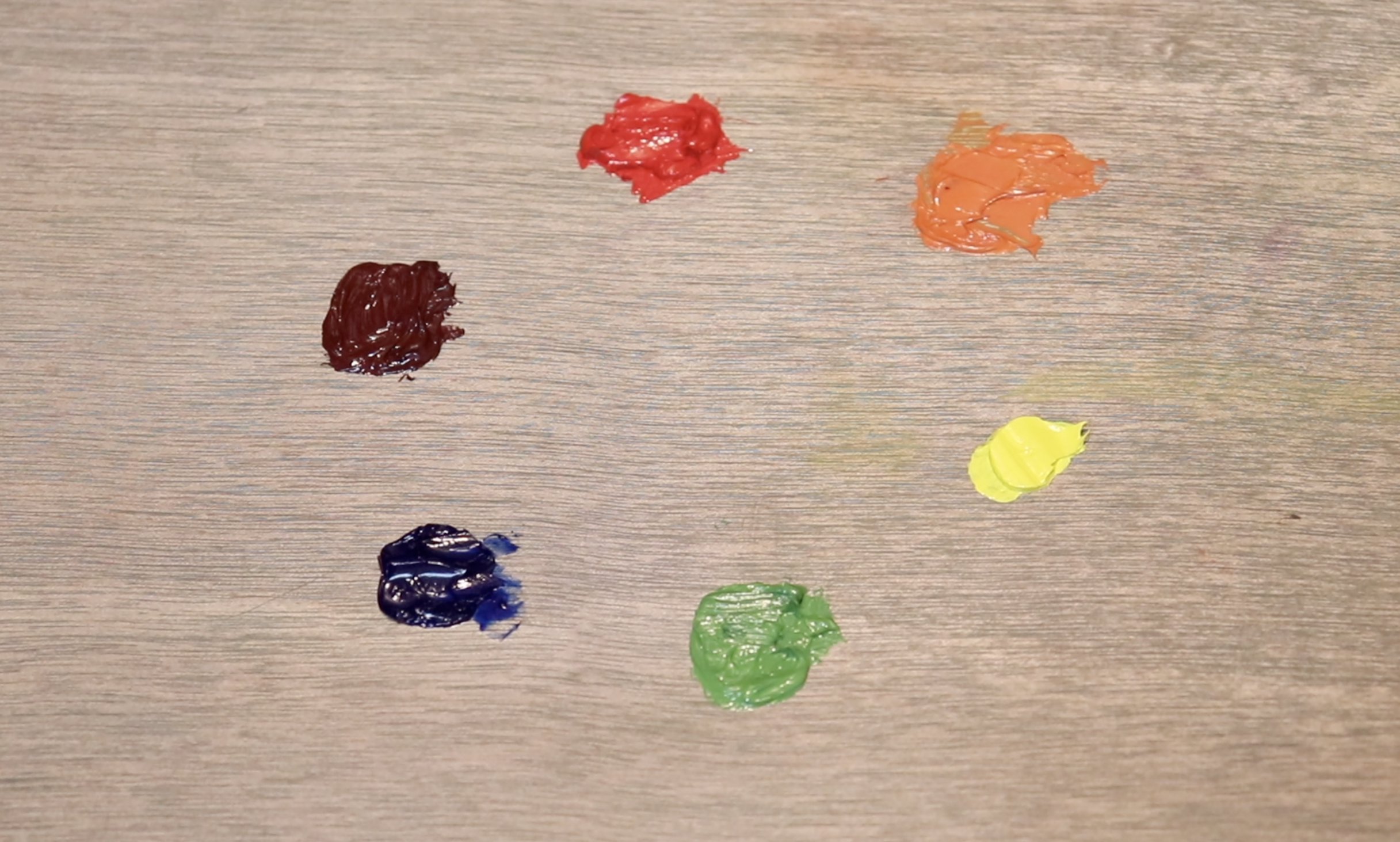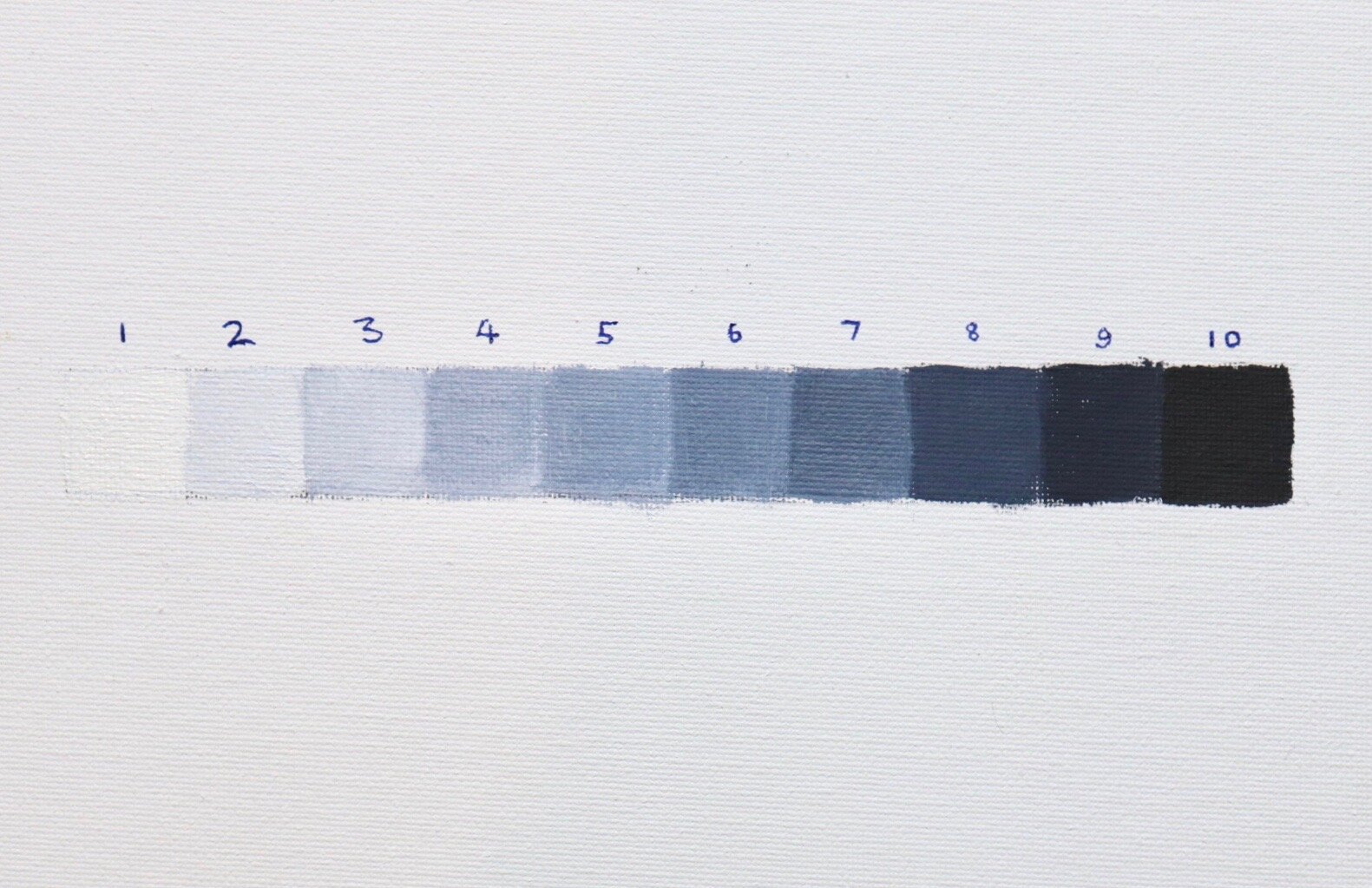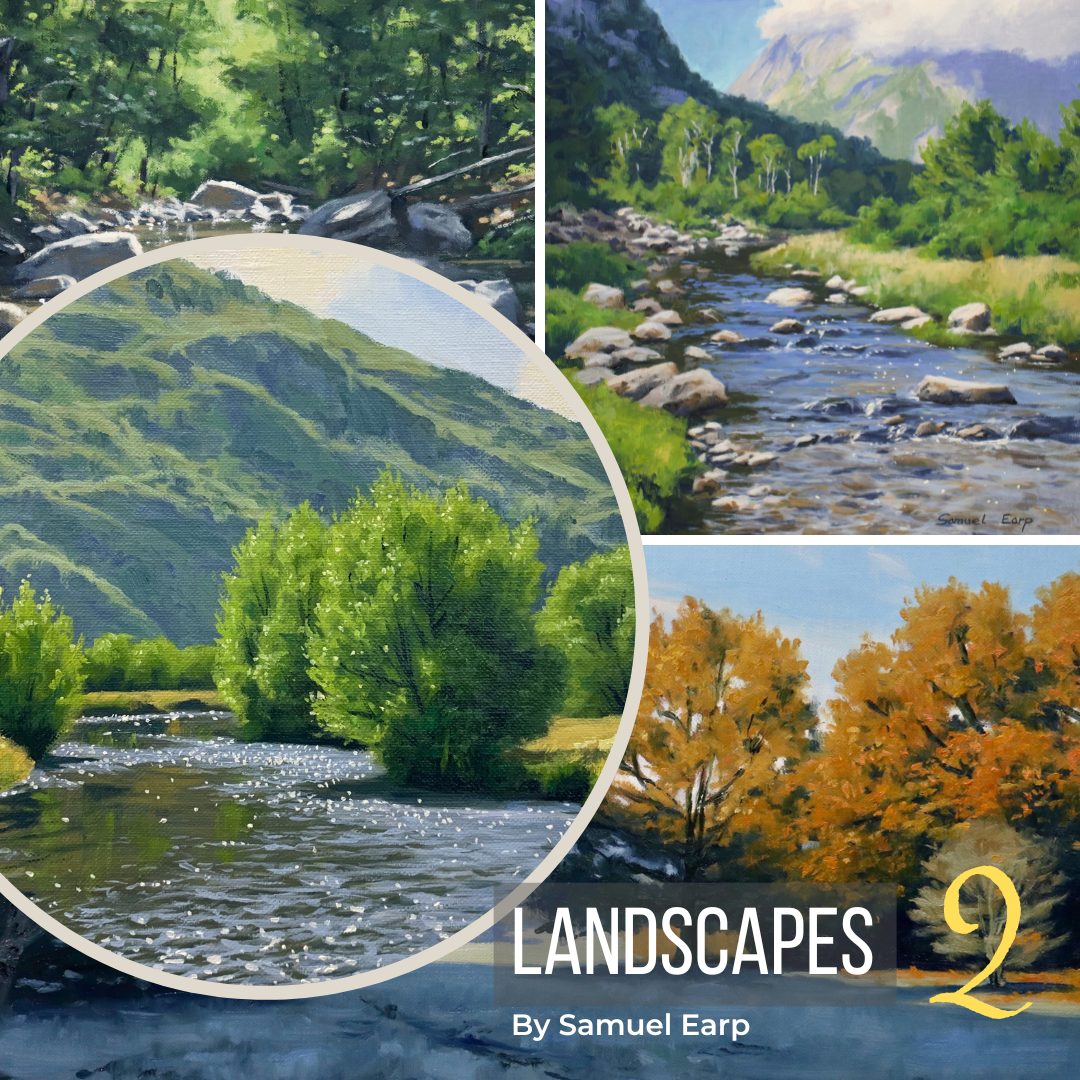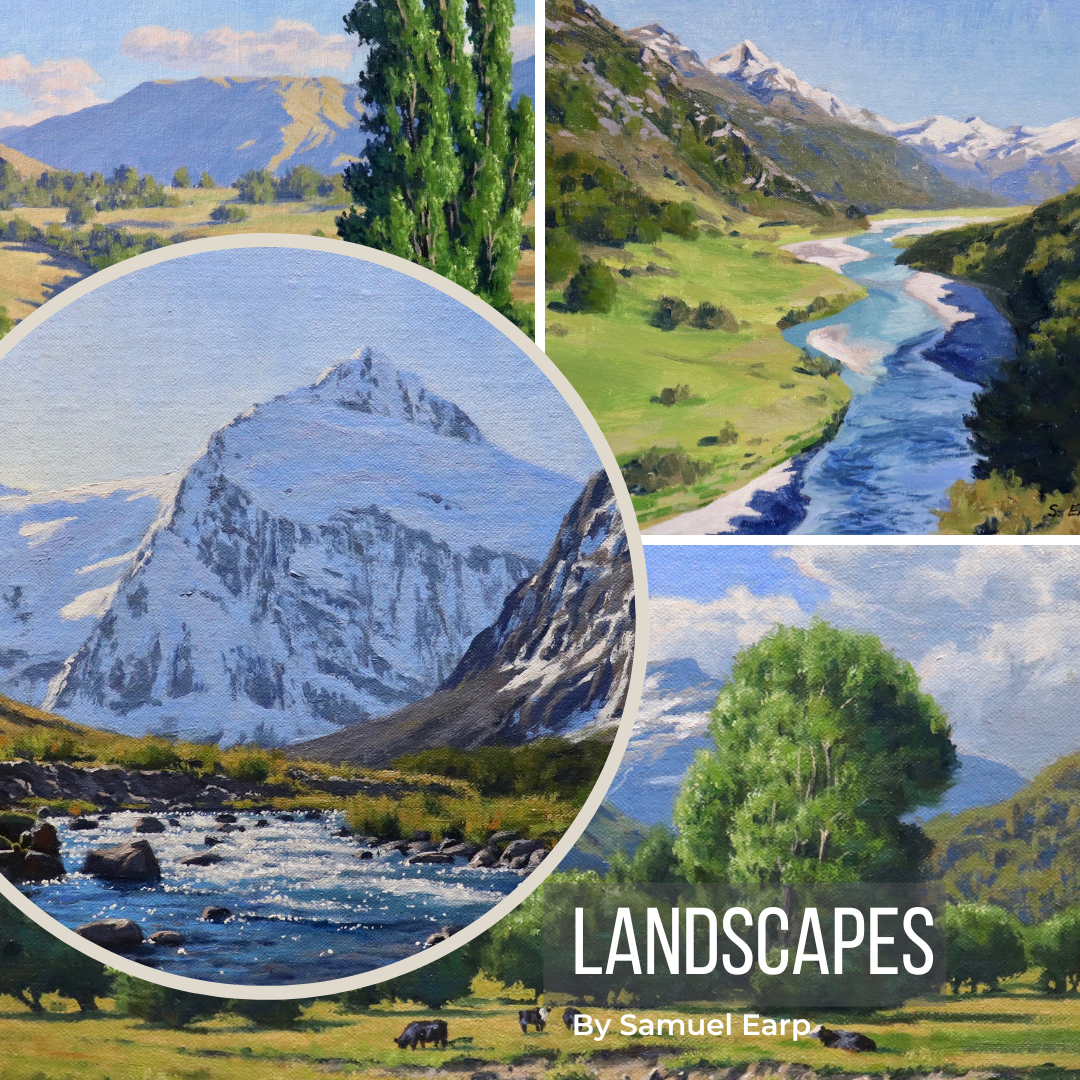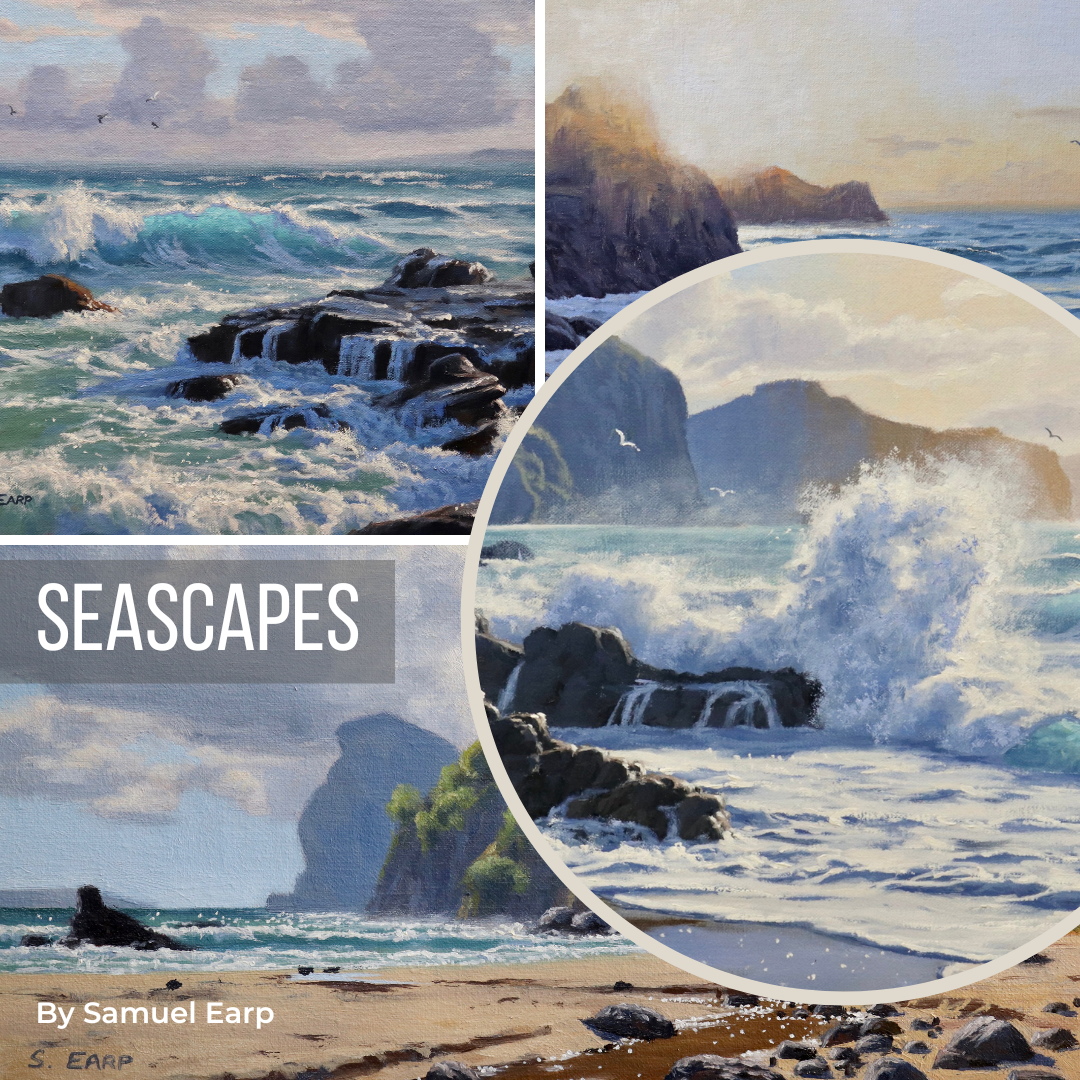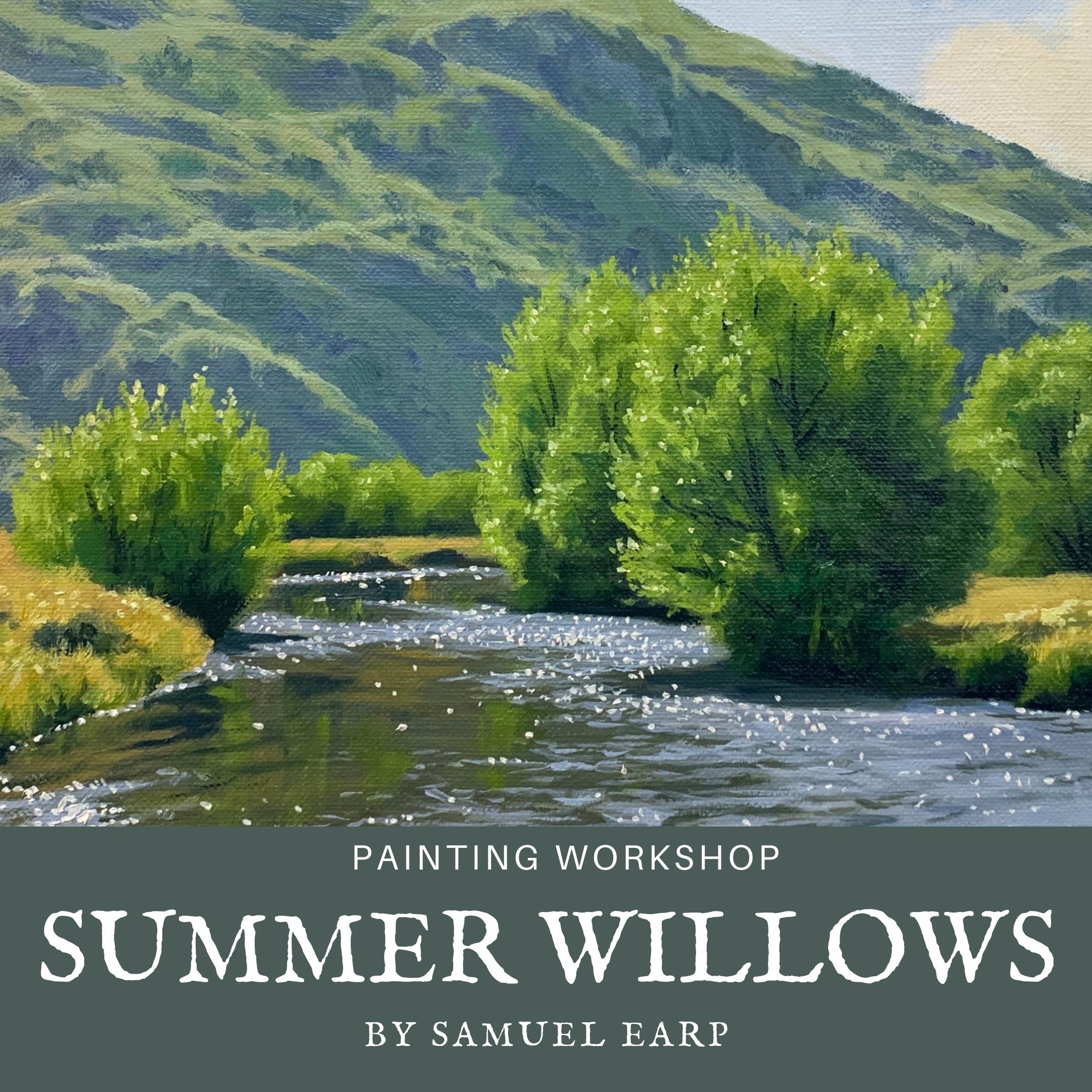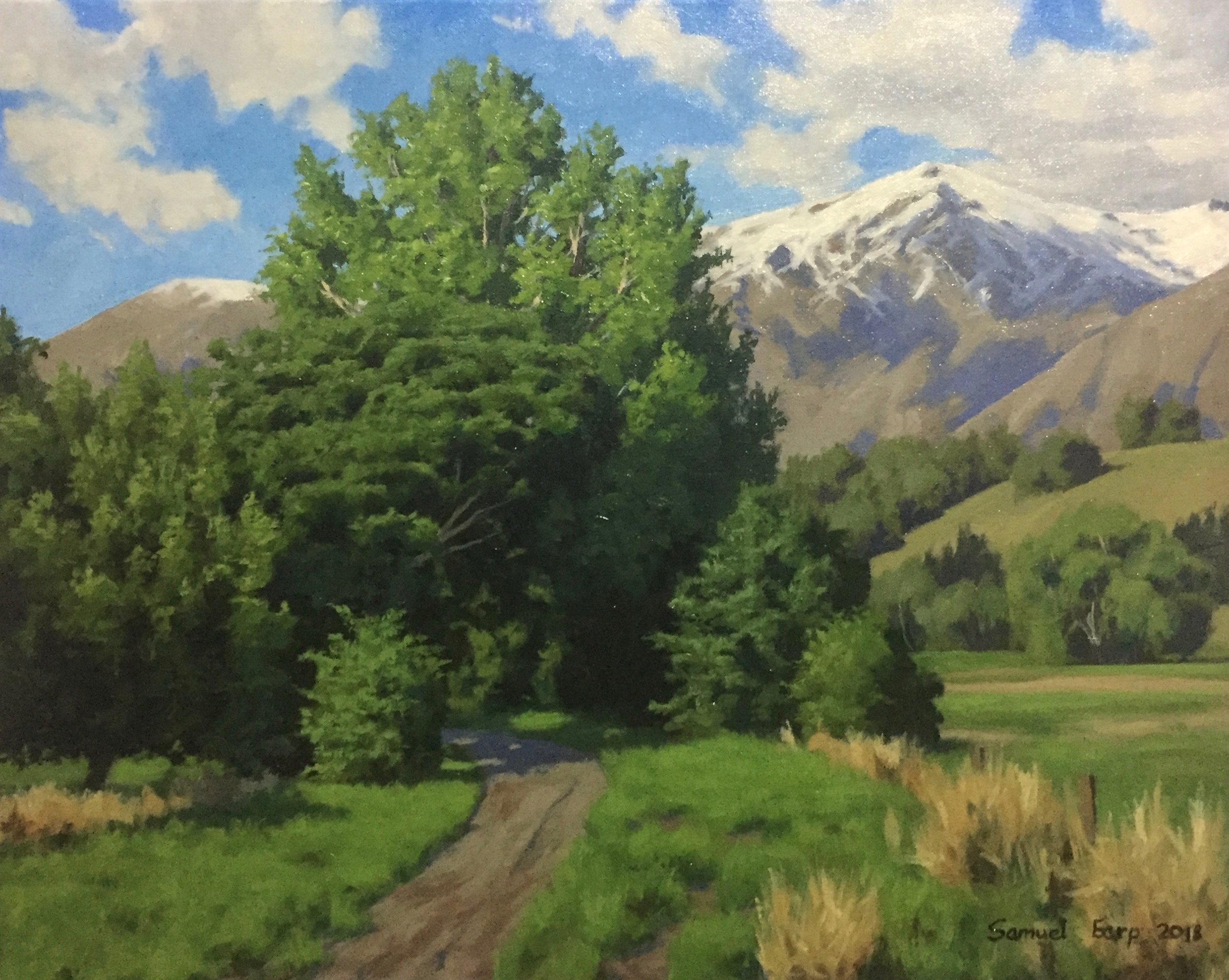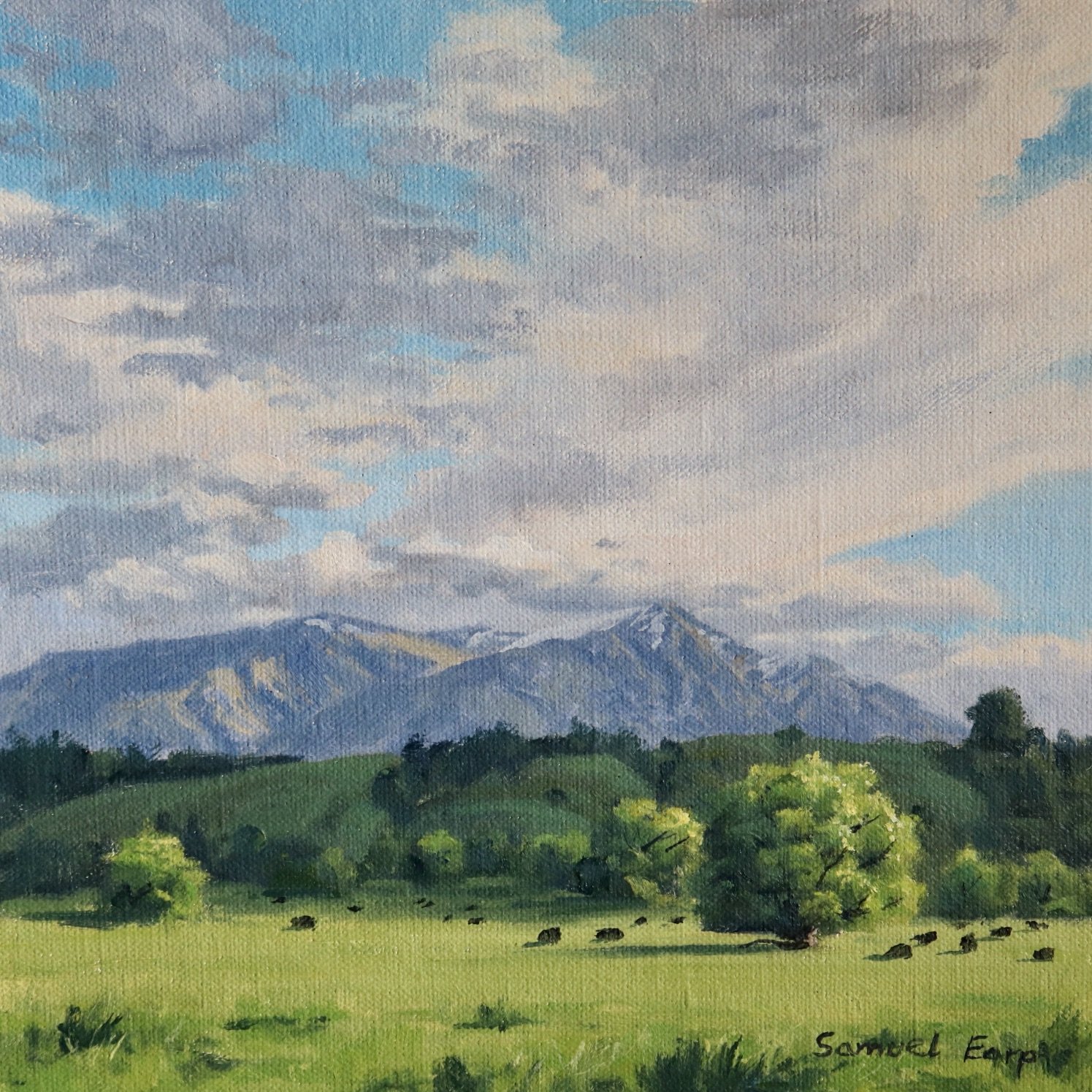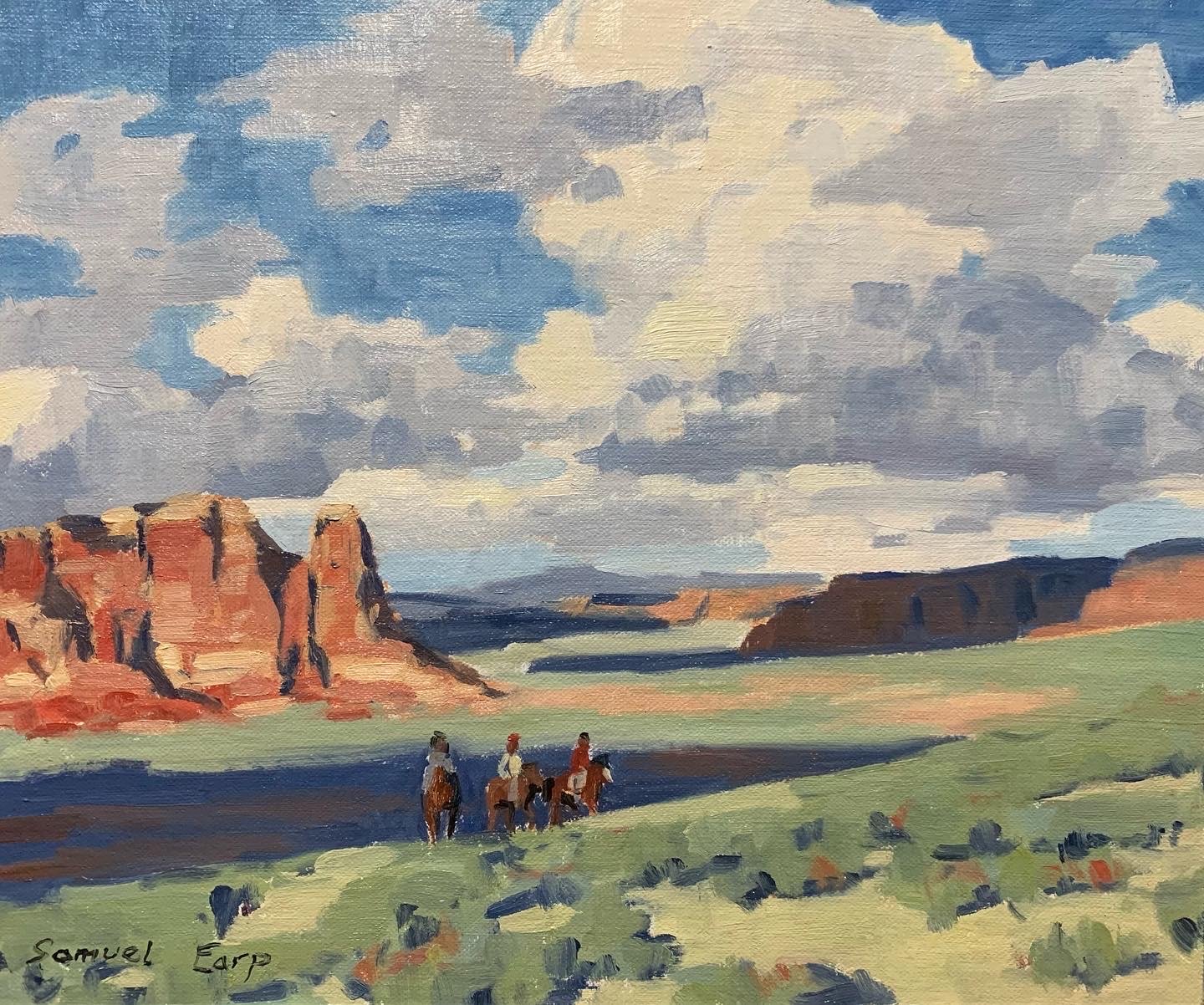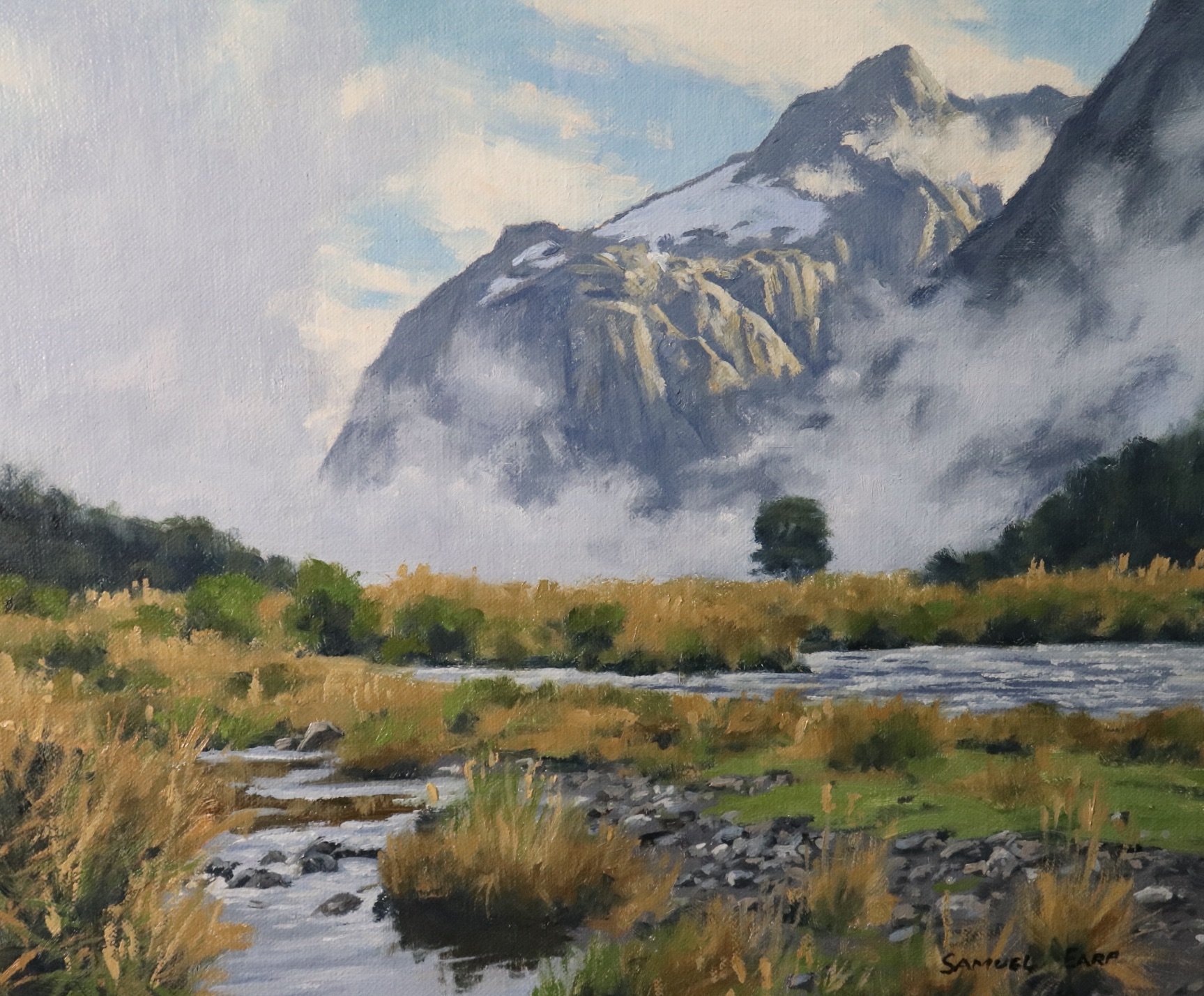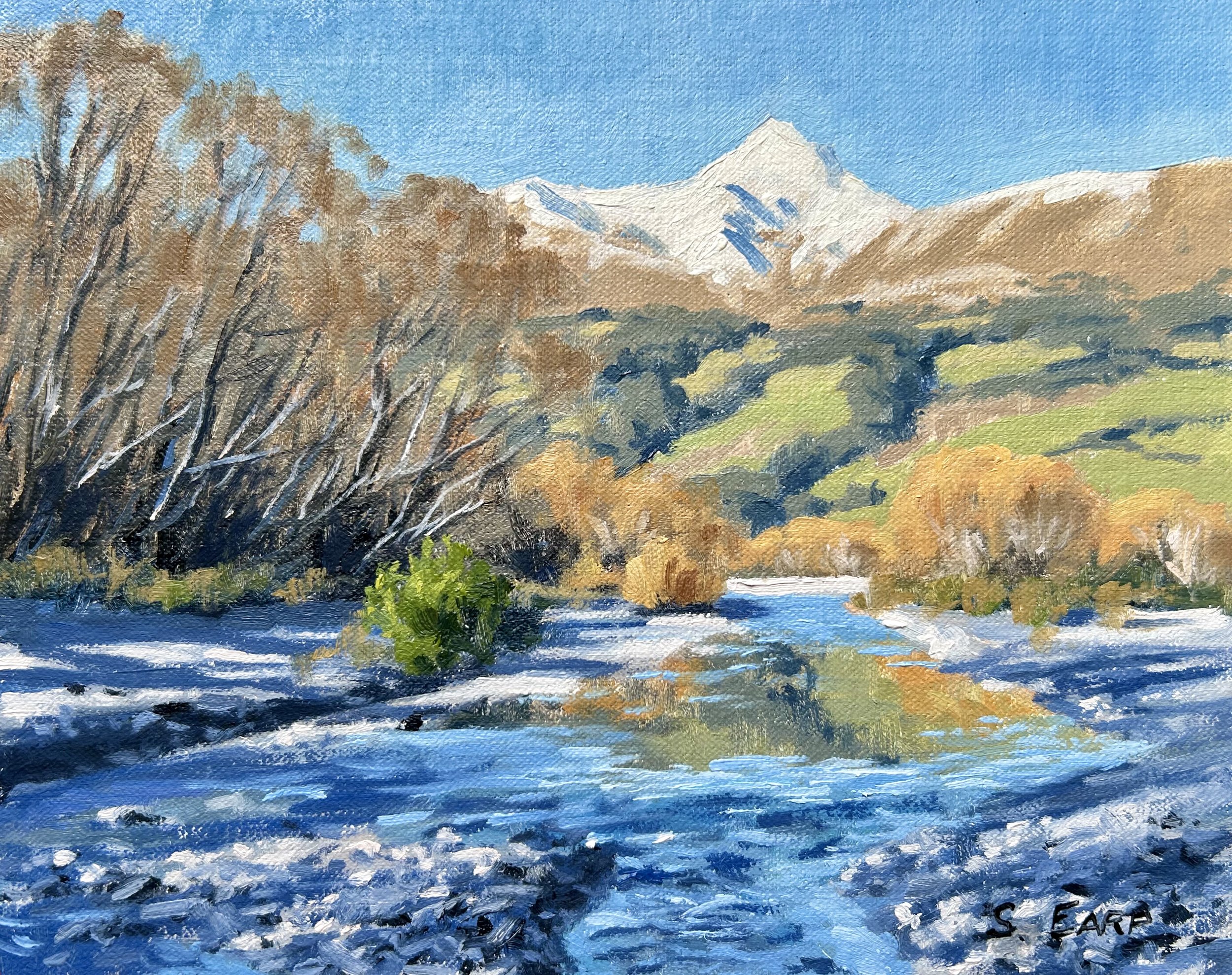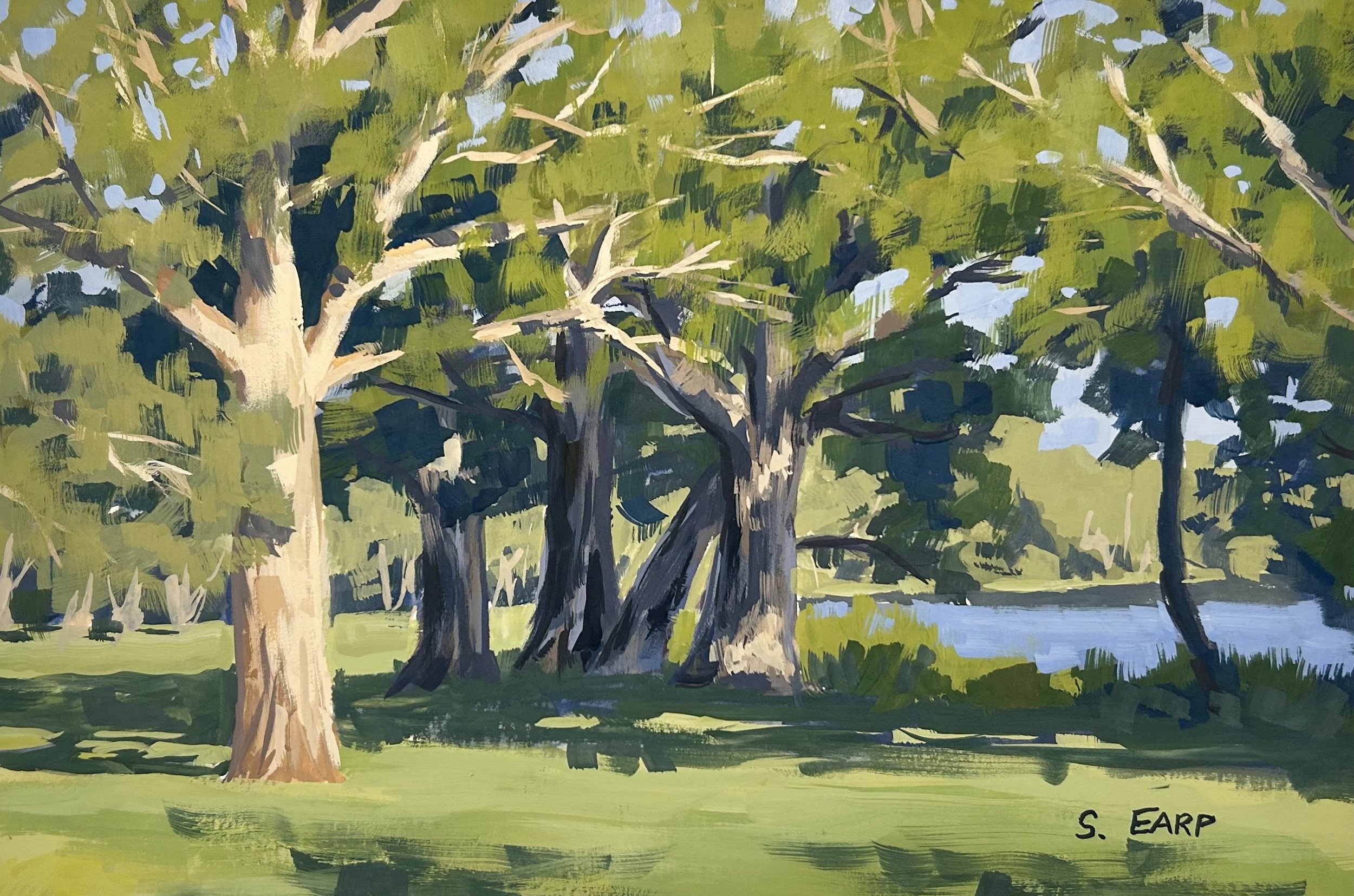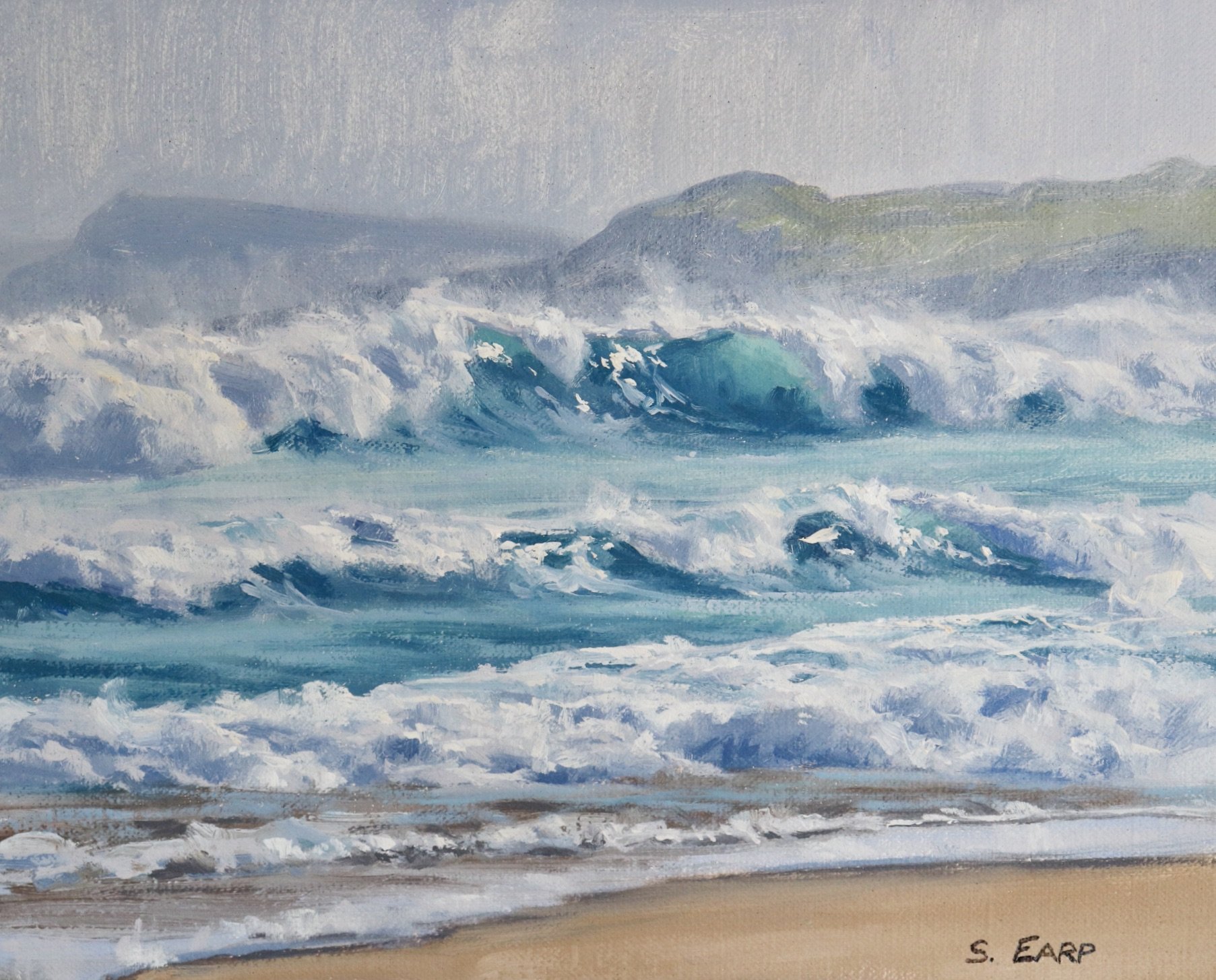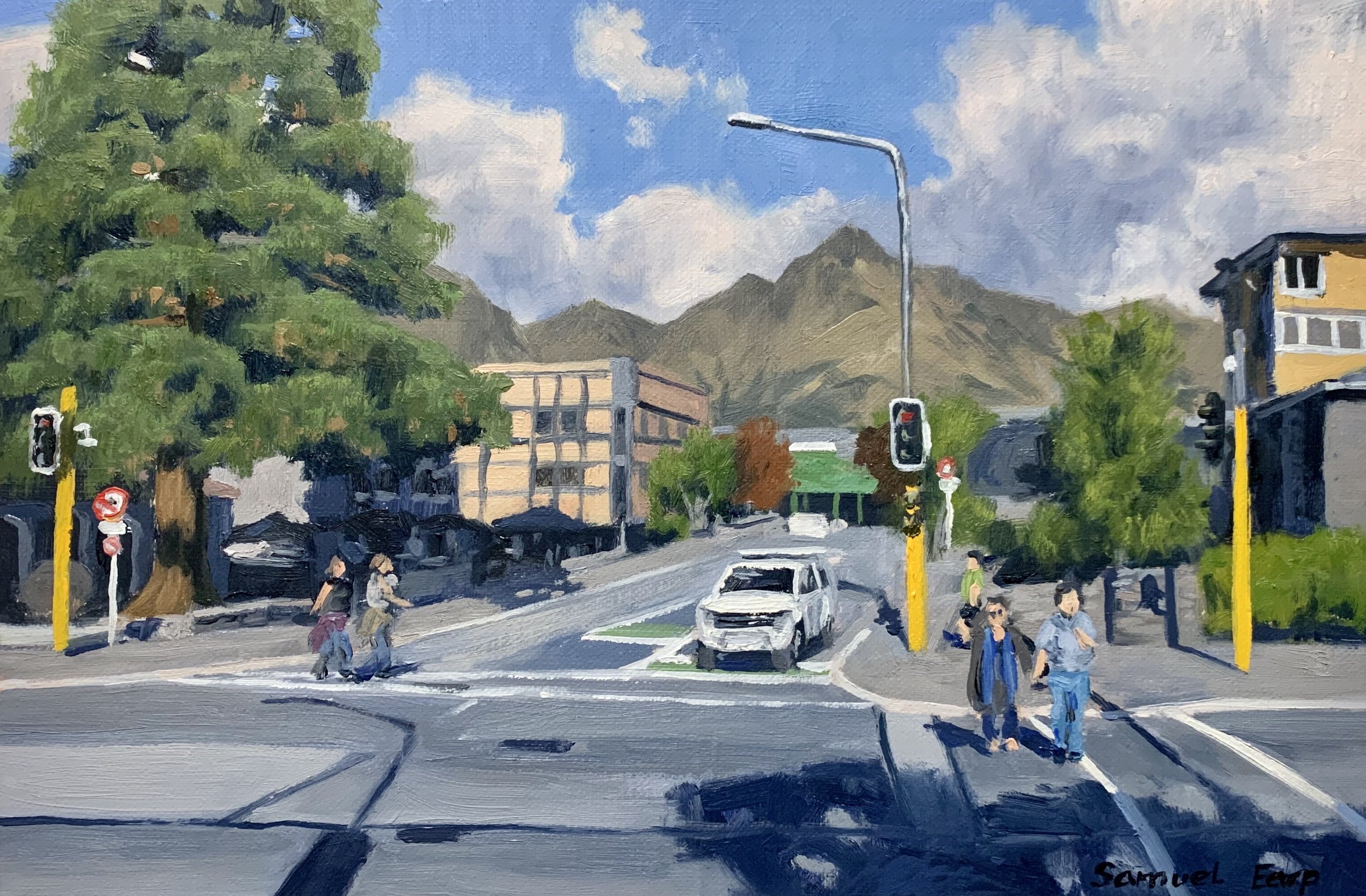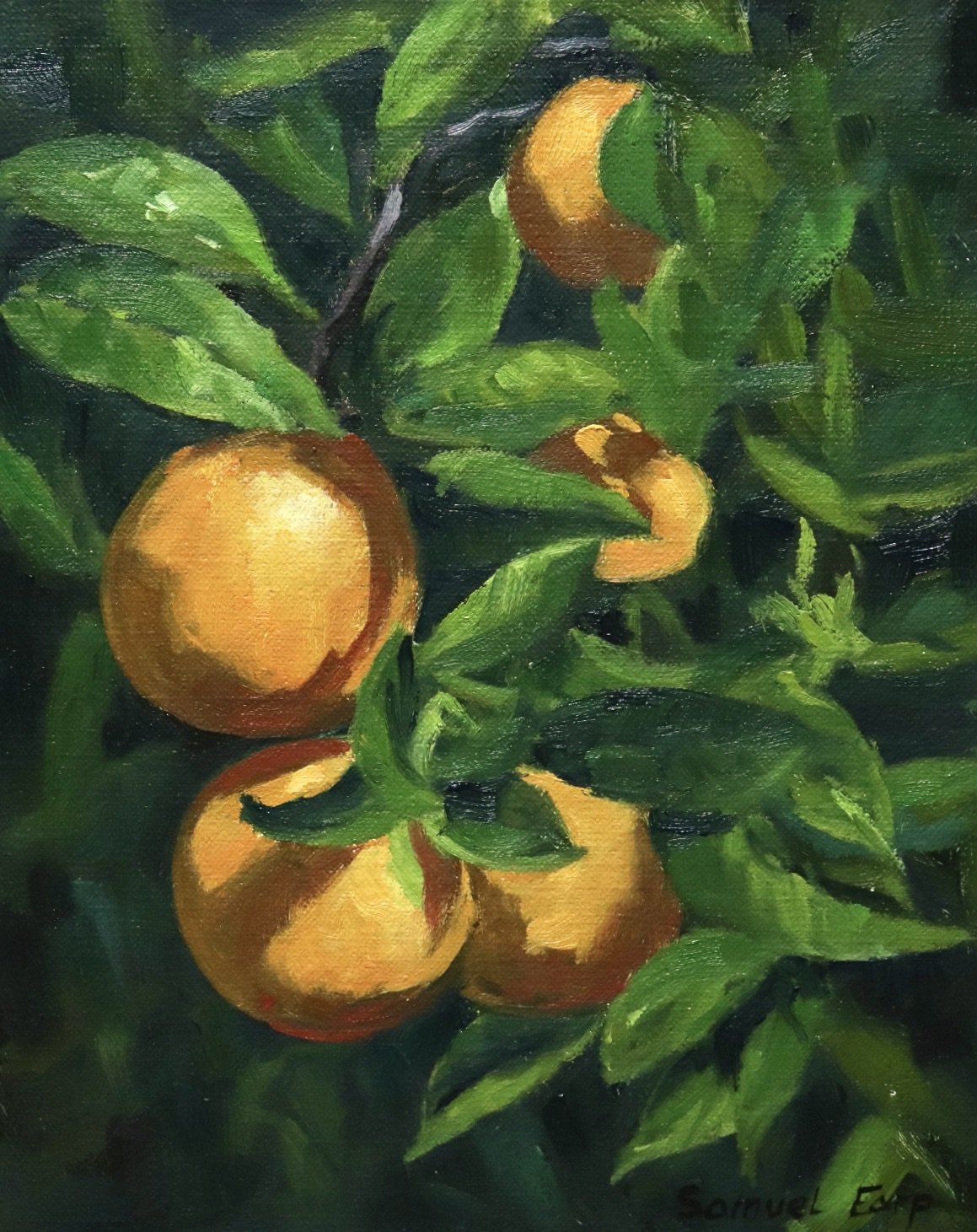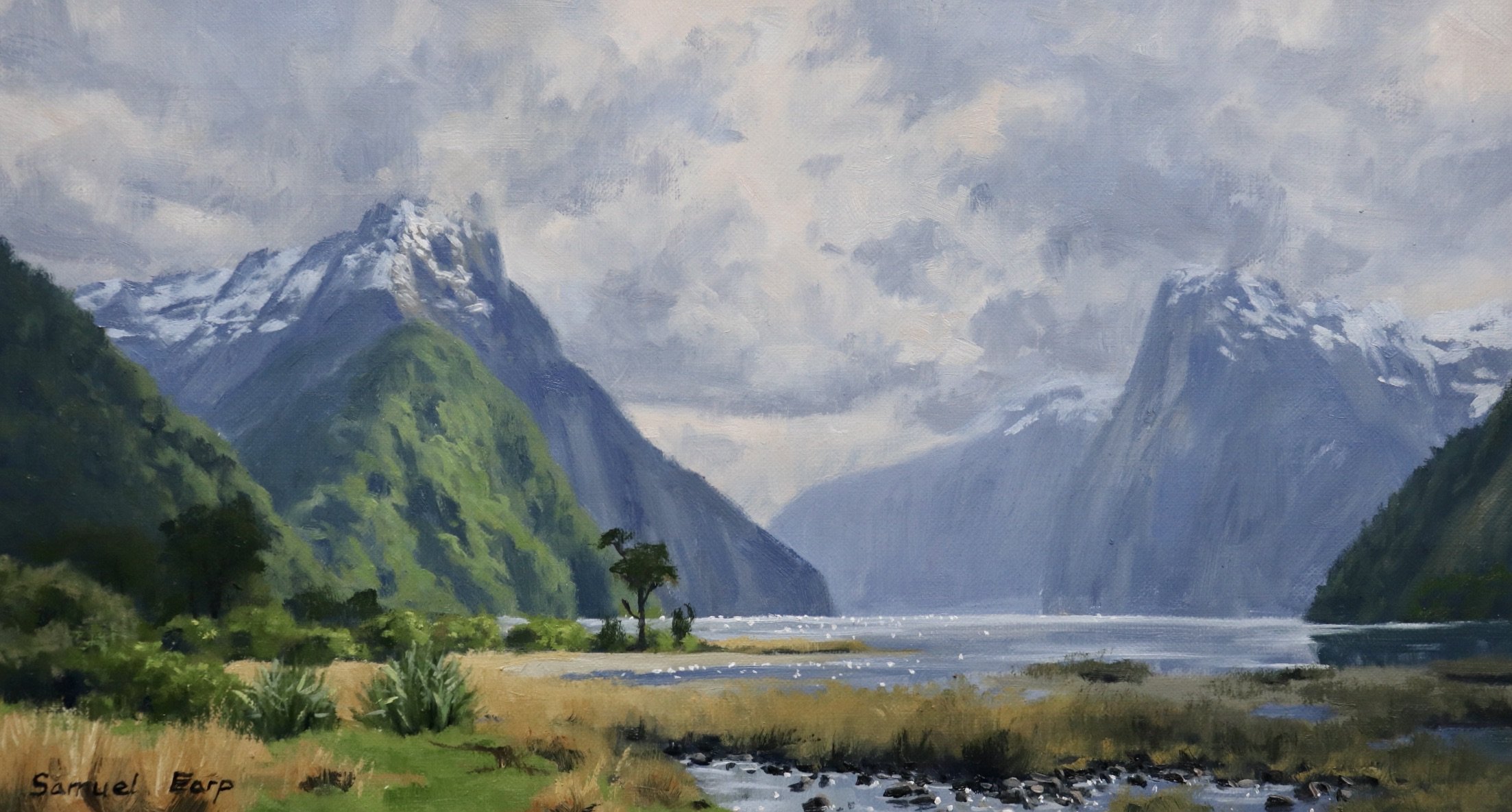Painting Workshop – Lesson Notes
Sunlit Trees
By Samuel Earp
Here are the lesson notes to accompany the Sunlit Trees painting tutorial video available on my Patreon channel. In the lesson notes and video I will show you how to paint this landscape that features a stand of trees that is backlit by the evening sun. This produces a beautiful translucency in the leaves.
Suitable for oils and acrylics.
Reference Photos
Here are the reference photos I took and used in this painting. Please feel free to use or copy these photos if you would like to have a go at painting this art work.
Colours
The colours I used in this painting are as follows:
-
Titanium white
-
Burnt sienna
-
Yellow ochre
-
Cadmium yellow
-
Cadmium orange
-
Alizarin crimson
-
Ultramarine blue
-
Phthalo green
Need Oil Paints?
I personally use Blue Ridge Oil Colors which are available here. If you would like to purchase Blue Ridge oil paints click the link below.
Brushes
Here is a list of the brushes I used in this painting:
-
No.5 flat
-
No.3 flat
-
No.2 flat
-
No.3 filbert
-
No.1 round
-
No.0 round
Need Brushes?
I personally use Rosemary and Co brushes which are available here. If you would like to purchase Rosemary and Co brushes click the link below. (Note: if you purchase Rosemary and Co brushes using the link below I will receive a small commission).
Composition
The poplar tree is the main focal area in the composition and the stream provides rhythm, leading the eye towards the stand of trees. I’ve made sure the poplar tree is not in the middle of the painting as centred objects cause a displeasing static in the composition. The poplar tree is to the right of centre.
Painting Demonstration
Stage 1 – Blocking in the Painting
I am painting on an 12” x 12” linen panel. The panel is pre made with a medium weave linen that is oil primed.
I sketch the composition using a No.1 round brush with burnt sienna mixed with Liquin Original (Liquin). I am using Liquin as a medium to thin the paint and it also has the advantage of speeding up the drying time.
I paint my dark values and shadows first whenever I start a painting. Value refers to how light or dark a subject and I find it easiest to create atmospheric depth in a painting by establishing the main areas of shadows first.
Here I paint the trees in the background with a mix of ultramarine blue, yellow ochre, alizarin crimson and titanium white.
The tree and grass shadows are a mix of mainly ultramarine blue and yellow ochre to create a dark low chroma green and I have adjusted the values by mixing in titanium white.
I mark in the stems and branches of the trees with a mix ultramarine blue and burnt sienna.
I paint a warm sky with a mix of titanium white, yellow ochre and a very small amount of alizarin crimson.
I mark in the areas of the tree foliage that is in full sunlight with a mix of yellow ochre, cadmium yellow, ultramarine blue, titanium white and a little alizarin crimson. I am mainly using No.5 flat brushes.
I paint the grass using the same colours I used for the poplar trees however I have used more titanium white in my mix so the value is lighter than the trees. In general trees are some of the darkest values to be found in the landscape whereas grass is much lighter, so I always keep this in mind when I paint grass.
I paint the half tones in the grass with a mix of yellow ochre, a little cadmium yellow, ultramarine blue, alizarin crimson and titanium white. I have also used a little phthalo green in the grass overall to increase the saturation and this I mix into my existing green I have made on my palette.
The tree reflection in the water is a mix of yellow ochre, ultramarine blue, burnt sienna and titanium white.
Overall I have kept my brush work loose and gestural so I can create an aliveness and painterly feel in this art work. At this point I let the painting dry and then I worked on it over a few session as I built up the detail in the painting.
Stage 2 – Adding Details
Once my painting was dry I spent time adding details to it. In general I use the same colours as I used during the blocking in stage but as I add more details I built up lighter layers especially in the grass. This helps to create more depth and realism in the painting.
Stage 3 – Final Details
It is at this stage that I have saved my lightest values until the end of this painting. I add some highlights to the leaves which was a mix of yellow ochre, cadmium yellow, phthalo green and titanium white.
I paint a few sparkles on the water with a mix of titanium white and a little burnt sienna. I apply the paint with a No.0 synthetic round brush.
Colours and Values
Throughout the video you will hear me talk about colours and values. It is important to have a basic understanding of colour theory and values when painting as it will make colour mixing easier for you. Luckily it’s easy to learn the basics and the rest is just brush mileage.
Colours Theory Terms
Below are some terms I use throughout the video and their meanings.
Hue: This refers to the main attributes of a colour and is dependent on its dominant wavelength, irrespective of how light or dark the colour is. For example, the colour is discernible as blue or a red etc.
Saturation or Chroma: This refers to the purity or intensity of a colour. You can reduce the saturation of a colour by adding a neutral grey or an opposite colour on the colour wheel.
Value: This is how light or dark a subject is. Getting your values correct is one of the keys in the success of a painting.
Tone: This is a broad term for describing a colour that is not a pure hue or black or white. It is a widely misunderstood term.
The Colour Wheel
For the benefit of people who are new to painting that are watching this video I will briefly go over the basics of the colour wheel. Knowing how the colour wheel this works can really help you with colour mixing.
Above is a simplified colour wheel. The colour wheel contains three primary colour blue, red and yellow and three secondary colours orange, green and violet.
When these colours are arranged on the colour wheel a primary colour is always opposite a secondary colour and are known as compliments or complimentary opposites. So, blue is opposite to orange, red is opposite to green and yellow is opposite to violet.
So why is this important?
If you want to desaturate a colour you can do this by mixing its complimentary opposite as the two colours will cancel each other out. In this manner you can create some neutral greys and browns especially when combined with white.
Complimentary colours also look good next to each other in a painting, for example greens often look more harmonious in a landscape if there are some reds amongst the mix or colours that contain red. If you look closely in nature, you’ll see naturally occurring complimentary opposites everywhere.
The Value Scale
Value is how light or dark a colour is and is perhaps one of the most important concepts in painting. The success of a painting rests on the relationship between the values in the painting. If they are not working and not in harmony, then the whole painting can lack any kind of depth.
Values in art work are represented on a scale with the highest value being white and the lowest value being black. The greys in between are known as mid or half tones.
In general, you will find your darkest darks and lightest lights in the foreground of a landscape. However, as landforms recede into the distance darks are not quite dark and lights are not quite light as the tonal scale narrows.
If you are unsure of where your light and dark values are in the scene you are painting, switch your reference photo to black and white and you’ll be able to clearly see where your light and dark values are.
In general, you’ll find that the sky is often one of the lightest values in the landscape. Grass is also generally lighter in value. Rocks and mountain faces are darker in value and often occupy the mid-tone range of the value scale. Trees are generally some of the darkest values in the landscape.
New Painting Video Every Month on Patreon
Subscribe to my Patreon channel and get instant access to all of my painting videos and get a new video every month for just $5 per month.
More Painting Tutorial Videos Available
